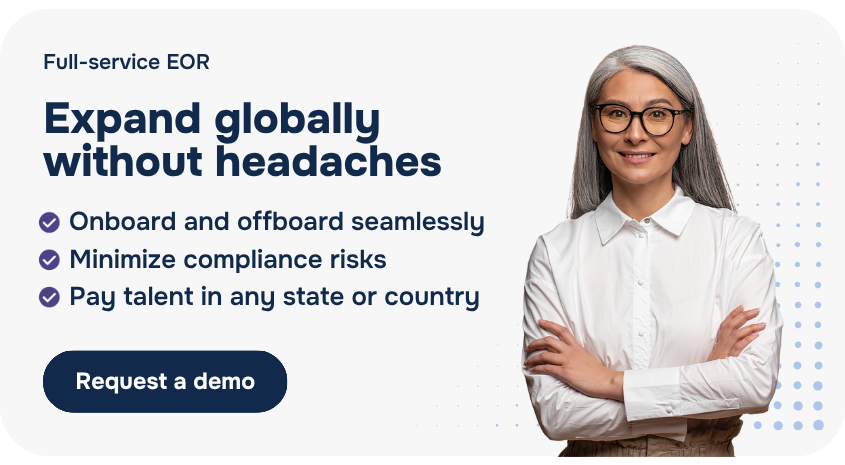Key takeaways:
- Full-service EORs manage payroll, compliance, and HR tasks end-to-end.
- EOR software suits teams with strong in-house HR and compliance capabilities.
- Full-service providers offer strategic partnership; software offers tools.
- Choosing the right model depends on resources, risk tolerance, and goals.
Navigating global workforce management requires the right Employer of Record (EOR) model. As more companies hire talent across borders, choosing between a full-service EOR provider and an EOR software platform is a crucial step.
EOR software, often seen as a self-serve solution, automates key functions for companies with robust in-house teams, while a full-service EOR acts as a strategic partner, handling the entire employment lifecycle and taking on the administrative and compliance burdens for you. Choosing the right approach depends on your organization’s internal resources, risk tolerance, and business goals.
What is EOR Software?
EOR software platforms allow companies to onboard talent and run payroll through a digital interface. Think of them as a do-it-yourself solution: The software streamlines certain processes and provides dashboards for managing worker data and payroll. For businesses with internal teams already equipped to handle global HR and compliance responsibilities, software platforms can provide structure and convenience.
However, it’s important to recognize that these platforms primarily provide the system, not the service. The responsibility for ensuring full legal compliance, navigating local employment nuances, resolving payroll or benefits issues, and managing employee relations often falls on the client. If your team lacks the expertise or bandwidth, software alone may not close the compliance gap.
Where EOR Software Falls Short
- Automated payment management: Platforms offer tools to pay talent, but the user is responsible for data entry and verification.
- Compliance support: The software may provide a framework of legal information and guidelines, but it’s up to your team to interpret and apply them correctly.
- Internal implementation: Requires your HR, Finance, and Legal teams to have the expertise and bandwidth to implement the solution and manage it internally.
- Minimal human interaction: The model emphasizes self-service, with live support often limited or available only at an additional cost, with no dedicated contact person.
Who Benefits Most from EOR Software?
EOR software can be a good fit for businesses with an in-house team of global HR, legal, and payroll experts who have the time and knowledge to manage all aspects of global employment. For a company with an established global infrastructure and compliance expertise in-house, EOR software offers a hands-on way to manage employment needs.
However, many organizations find the DIY approach presents significant challenges:
- Compliance Complexity: Employment laws are constantly changing and vary significantly between regions. EOR software provides a starting point, but a misinterpretation of a specific worker protection, tax rule, or required benefit can lead to costly fines and legalities.
- Worker Misclassification Risks: Without a comprehensive vetting process, the risk of misclassifying an employee as an independent contractor is high. Software platforms often provide little support to mitigate this risk, which can result in severe financial penalties and reputational damage.
- Limited Customer Support: The self-service model is designed to minimize costs, but this often comes at the expense of live, expert assistance. When a payroll or compliance issue arises, trying to resolve it online with a chatbot or a generic help desk ticket can slow down operations and lead to worker dissatisfaction.
- Unexpected Costs & Growth Fees: EOR software platforms typically have subscription-based pricing with fixed license fees that aren’t always tied to active headcount. As your workforce fluctuates, you might find yourself paying for seats you’re not fully using. What’s more, these fixed fees often don’t account for the complexity of hiring in new states or countries, leading to unexpected costs and additional fees as you expand.
When to Transition to a Full-Service EOR
You may find yourself outgrowing EOR software if your organization struggles with scalability, compliance, or employee satisfaction . For example, businesses expanding rapidly across multiple states and countries typically need strategic, proactive support to ensure every hire is compliant from day one. When your team is spending more time on administrative tasks than on strategic growth, it’s time to consider a full-service EOR provider.
What is a Full-Service EOR?
A full-service EOR is a strategic HR partner. In addition to offering software solutions, full-service providers also assume legal responsibility for compliance while handling employment administration end-to-end. That means they don’t just give you the tools; they do the work for you.
With a full-service EOR, companies can expect comprehensive support, including:
- Compliance management: Navigating local labor laws, tax regulations, and worker classification rules.
- Payroll & Tax Administration: Processing payroll accurately and filing local taxes on your behalf.
- Employee onboarding & offboarding: Handling contracts, documentation, and exit processes.
- Benefits administration: Offering compliant, locally appropriate benefits packages to attract and retain talent.
- Risk reduction: Taking on liability for employment, minimizing exposure to penalties and claims.
- HR expertise: Providing guidance on employee relations, policy creation, and labor law nuances.
This end-to-end support allows businesses to expand confidently, without overburdening internal HR or Finance teams.
Key Benefits of Full-Service EOR Providers
- End-to-end employment management: A full-service EOR manages the entire talent lifecycle, including onboarding/offboarding, payroll, benefits, timekeeping, compliance, and more.
- Dedicated expertise: You gain access to a team of specialists who are experts in local labor laws and global workforce management, with strategic support across time zones. This includes a single point of contact, a dedicated account manager, who knows your business and your workforce.
- Risk mitigation: The provider assumes full legal responsibility for compliance, payroll, and benefits, significantly reducing your company’s exposure to risk. They also have robust vetting processes for independent contractors to prevent misclassification.
- Human-first approach: A full-service provider is more likely to offer high-touch, live support from real people who are available when you need support.
Who Benefits Most from Full-Service EOR Providers?
Organizations that lack a strong internal global HR infrastructure or are expanding into unfamiliar regions will find a full-service EOR invaluable. This consultative, high-touch model is ideal for medium to large businesses managing distributed workforces, including contingent workers like independent contractors, freelancers, project-based contractors, and temporary or seasonal employees.
It’s also helpful for companies seeking a partner who provides tailored solutions and can help them scale quickly and compliantly without adding HR and legal headcount to manage the increased demands of a growing workforce.
In short, software gives you the platform, while a full-service EOR gives you the partner.
What is the difference between EOR Software and Full-Service Providers?
| Feature | EOR Software | Full-Service EOR |
| Compliance | Offers tools and resources, but client retains responsibility | Provider assumes liability and navigates local labor laws, tax regulations, and classification for you |
| Payroll & Taxes | Automated payment processing; client may need to manage exceptions | Provider manages payment and filings, and resolves issues |
| HR Services | Limited; mostly self-service through software | Full HR support including onboarding, benefits administration, and offboarding |
| Risk Management | Client bears the risk if errors occur | Provider assumes employment-related risk |
| Customer Service | Digital support, often ticket-driven | Dedicated experts and account managers |
Compliance Risks to Consider
Regardless of the EOR model you choose, compliance is a critical factor. Missteps can lead to severe penalties, financial losses, and damage to your company’s reputation. Here’s a look at how compliance risks differ:
EOR software risks:
- Worker misclassification: The self-serve nature of the software may lead to unintentionally misclassifying workers, which can result in costly fines.
- Noncompliance: Without a dedicated expert providing guidance, it’s easy to miss specific regional regulations, such as tax laws or required employee benefits.
- Lack of proactive support: Software platforms lack the human touch to proactively identify and address potential risks before they become a problem.
Full-service EOR risks:
- While these providers handle compliance proactively, selecting a partner without a proven track record can lead to hidden fees or poor service. Innovative Employee Solutions (IES) mitigates this risk with transparent pricing, a human-first approach, a 8% compliance rating, and over 50 years of experience.
Key Factors to Help you Decide Between a Full-Service EOR and EOR Software
To choose the right EOR model, consider the following factors:
- Internal resources and expertise: Do your HR and Finance teams have the global legal and compliance knowledge to manage a distributed workforce? If not, a full-service provider offers the guidance and expertise you need to stay compliant.
- Budget considerations: While EOR software may have a lower sticker price, it often comes with additional costs. These can include fees for hiring in a new state or country, as well as costs related to your internal resources required, potential compliance penalties, and a lack of dedicated support. Full-service EOR providers typically have custom pricing tailored to your business. For example, IES offers flexible, transparent pricing based on real factors like worker location, headcount, and service complexity. With a full-service EOR, your monthly cost may be slightly higher, but the long-term value — from time savings, reduced strain on internal resources, and mitigating compliance risks — can far outweigh the difference.
- Business goals: Are you looking for an out-of-the-box solution to manage payroll, or a tailored, high-touch partner to help you grow with confidence? Full-service EORs excel at customization and scalability, providing a true partnership.
Checklist for Decision-Making
- Is your workforce spread across multiple countries or US states?
- Do you hire contingent workers, like independent contractors or project-based employees?
- Are compliance risks, such as worker misclassification, a significant concern?
- Does your organization lack in-house global HR or legal expertise?
- Are you seeking high-touch support and a true partner for workforce expansion?
If you answered “yes” to most of these questions, a full-service EOR is likely the better option for your business.
Matching Your EOR Choice to Your Business Strategy
Ultimately, choosing between EOR software and a full-service EOR depends on your business’s specific needs, resources, and goals.
- If you have strong internal HR, legal, and compliance resources and primarily need a system to centralize payroll, an EOR software platform may be sufficient.
- If you want peace of mind, risk reduction, and the ability to offload administrative burdens while ensuring compliance everywhere you operate, a full-service EOR is the better fit.
The Future of EOR Workforce Management Solutions
As workforce needs continue to evolve, technology will always play a role. Full-service EOR providers, like IES, will continue to leverage technology to enhance their services, offering a hybrid model that combines the efficiency of software with the personalized support and compliance expertise that businesses need to thrive in a global marketplace.
Why IES Stands Out as a Full-Service EOR Partner
At Innovative Employee Solutions, we’ve spent over 50 years helping companies expand globally with our full-service global Employer of Record solutions. We handle the complexities of global and U.S. employment — including payroll, compliance, HR administration, and risk management — so you can focus on growing your business.
When compliance and employee experience matter most, a full-service EOR like IES provides not just a platform, but a partnership. With industry-leading customer service and a Net Promoter Score (NPS) 80% above the industry average, IES is the trusted full-service EOR for growing teams seeking a strategic partner to manage the legal, administrative, and operational complexities of a distributed workforce.
Ready to explore whether a full-service EOR is the right fit for your business? Connect with IES today and learn how to simplify global hiring and compliance for your team.
About the author: Sara Jensen is the Senior Vice President of Growth & Strategy at Innovative Employee Solutions (IES), a leading provider of remote and contingent workforce solutions, specializing in full-service global Employer of Record, Agent of Record, and Independent Contractor compliance services in the U.S. and 150+ countries. Founded in 1974, IES is a woman-owned business, certified by the WBENC and partners with companies to provide compliant employment solutions that empower people’s lives.







